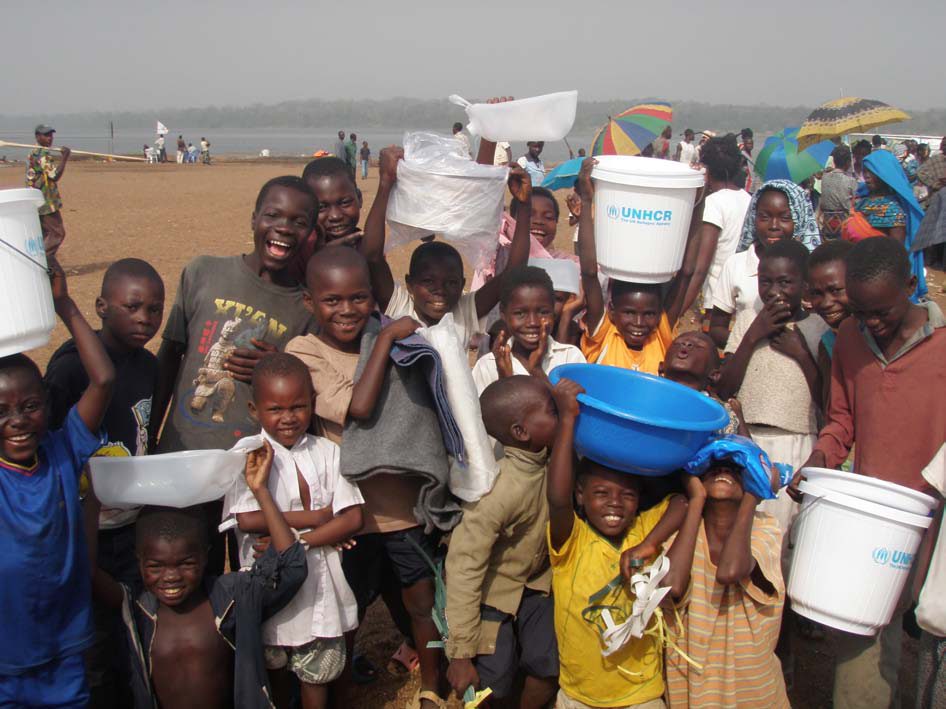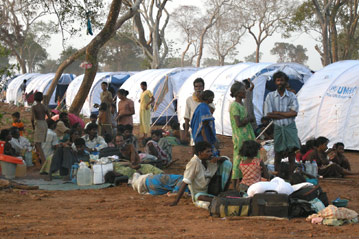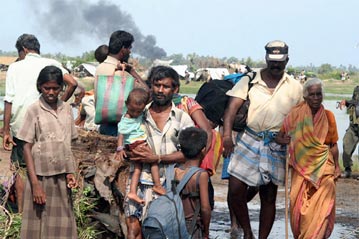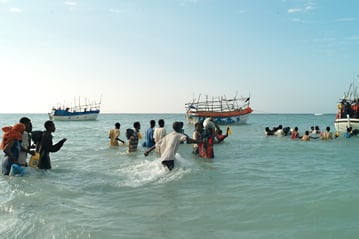Feature: Climbing Mt Everest - how a refugee camp is built
Feature: Climbing Mt Everest - how a refugee camp is built

HAJER HADID, Chad (UNHCR) - Abdulai Sahalet stood in the middle of an expansive grass field with the look of a proud landowner and pointed into the distance with his outstretched arm. The green hills of the rainy season framed the scene, a haven of tranquillity not far from the teeming Breidjing refugee camp. "That is where the medical centre will be located," said Sahalet of the Chadian Red Cross.
At one end of the meadow punctuated by acacia trees, workers were digging trenches. Others busied themselves with the essential task of constructing latrines. The cows, sheep and goats that grazed here until recently will be gradually replaced by 3,300 tents and 750 latrines dispersed around 413 communities, each one composed of eight tents.
"Before there were cattle everywhere," said Sahalet. "Now they have to go very far to graze." The reason? The bucolic 127-hectare site is the setting for Treguine, the 10th UNHCR camp in eastern Chad that opened on September 27 and that will eventually be the temporary home of 15,000 Sudanese refugees.
For most people, a refugee camp conjures up images of long rows of tents, food distribution centres, and children running about. But building any camp is a long, complicated process comparable to establishing a medium-sized village from scratch, often in the middle of nowhere.
Treguine is an ideal example of the remarkable technical, political and diplomatic skills required to successfully build a refugee camp. Because millions of people live in such camps around the world, getting it right despite the awesome obstacles is crucial. In the case of Treguine, a seemingly endless series of problems came close to scuttling the entire project.
Choosing the site
"The biggest issue is that of the land, making sure it has natural resources. Then there is the question of the shape of the terrain, the type of trees and grass that are present, the composition of the soil," says Langdon Greenhalgh of the International Federation of Red Cross and Red Crescent Societies (IFRC), which is building the camp and will manage it jointly with the Chadian Red Cross.
The Treguine site near this village was chosen because of its proximity to Breidjing camp, which would make transferring thousands of refugees much easier, and the supposed availability of water, a crucial factor in this desert region where the rainy season lasts four months of the year at best. But those factors brought their own problems, which took UNHCR staff and their operating partners months of hard, frequently frustrating work to resolve.
Negotiating for land
The first hurdle to overcome was the political problems. The 10,000 or so residents of Hajer Hadid village and the surrounding communities complained bitterly to local authorities that their pastoral and agricultural land was being expropriated. In exchange, they demanded that UNHCR build a water tower and pump to provide the village with water.
"We signed an agreement to build a water supply system fed by wells," said Christophe Hamm, the emergency coordinator in UNHCR's Adré office, which is responsible for the Breidjing, Farchana and Treguine sites. "But when the Red Cross arrived to begin the actual work, the local residents, supported by the Sub-Prefect, made other demands."
This time the residents asked to be compensated for their lost agricultural and grazing grounds with food donations from the World Food Programme. The request was rejected by UNHCR because the camp did not infringe on any farmland. The local authorities then demanded that the refugees not be allowed to bring their animals, an unacceptable request given that international humanitarian law allows refugees to enter the camps with their possessions. So the Prefect was called to explain to the locals that the refugees had the right to have their animals with them. Because the land in question belongs to the Chadian government, the always thorny issue of expropriation did not apply in the case of Treguine.
An agreement between the Chadian government and UNHCR allowing the refugee agency to establish Treguine camp was signed on August 25, and work on the camp could finally begin in earnest.
Local perks
The concerns of the local population are understandable. A refugee camp can fundamentally change the economic, political and sociological structure of a community. Treguine camp, for example, will house about 5,000 more people than the surrounding villages put together.
"You are going to change the makeup of the community itself, sometimes for the better if you do it right," said IFRC's Greenhalgh. "You hire workers, security guards, and personnel for the health centres if they are qualified. It can be a positive thing for the community."
Support for the local population comes in other ways. When UNHCR, its World Vision partner and WFP instituted a blanket supplementary feeding programme in all of the Chadian camps this summer to combat alarmingly high rates of malnutrition among refugee children, the programme was extended to include the same target groups - all children under five years old as well as pregnant and lactating women - in the nearby villages.
"You can't just set up a health centre for refugees and not take care of the medical needs of the community itself," said Greenhalgh. "If you are going to be giving out jerry cans and blankets in the camps, we should at least consider if those items are needed by the local people too."
The search for water
Despite the complexity of the political problems, it was water, or rather the lack of it, which posed the biggest challenge. At one point, UNHCR considered giving up on the site entirely because an adequate water supply could not be ensured during the long dry season that runs from October to May. Indeed, over the past several months, UNHCR pinpointed several sites in eastern Chad only to abandon them because of the lack of sufficient water. A French technical expert carried out preliminary satellite studies of the region, but Treguine had already been chosen and was therefore not among the sites he studied.
In retrospect, the location of the wells on the camp site turned out to be the biggest problem. After workers completed drilling the wells, experts concluded all were nearly dry. Furthermore, interviews with local women revealed that this village's 4-metre-deep well, deeper than those at the camp site, did not provide sufficient water through the dry season.
Hydro-geologists and other experts were called in to further explore the surrounding area by drilling boreholes where the sediment from the nearby wadi, a seasonal dry river bed, was thick enough to hold water reserves. "There are very few places in the world where it is not possible to find water," said Gabriel Salas, a UNHCR consultant with 30 years experience looking for water resources in the world's desert regions.
Salas would be eventually proven right, but first UNHCR had to deal with yet another problem - mango groves. Because the boreholes were drilled in an area where mango groves grow, local residents thought they would lose one of their few sources of income. They marched on the site and halted the drilling. More negotiations followed, during which it was explained that the mango groves as well as some farmland would not be adversely affected by the boreholes. "Once the camp is gone, the local people will have an incredible source of water they would not have had otherwise," said IFRC's Greenhalgh.
The first borehole will be able to provide water for 4,000 refugees. But the really good news came when the second borehole was drilled. This one found enough water to provide 15 litres per day per refugee (the UNHCR standard) for 15,000 people for at least 10 years, according to the experts. The next step is to install high pressure water pipes to transport the water from the source to holding tanks. In the meantime, Oxfam, a British non-governmental organisation that is responsible for managing the water system at the camp, buried an 11-cubic-metre tank in the nearby river to supply water for three to four months.
Treguine would finally become a reality, but the difficulties encountered demonstrated the need for a new approach to choosing camp sites. "We want to change the process," said Nico Hartz, senior site planner for UNHCR in eastern Chad. "First we have to make sure enough water is available, then deal with the problem of the availability of the land."
A model for future camp sites
Despite the challenges, Treguine is considered a model for future camp sites by UNHCR. After consulting with the refugees, the usual endless parallel rows of tents will be replaced by groups of tents arranged in a circular design similar to the villages the refugees left in the Darfur region of western Sudan. Each block will consist of eight tents housing a total of 40 persons. One family of four or five will be assigned to each tent. In the middle of the block, an open space will serve as a community gathering area.
"It will be a space where people can communicate," said Francis Lacasse, a programme coordinator with Oxfam in eastern Chad. "You create life."
Yaya Adam Ibrahim, his wife and three children were among the first to move to the new camp after spending more than two months in Breidjing without a proper tent. "From the moment I arrived and saw the set-up, I was very happy," he said, standing in front of his new tent. "Even the children are happy." His brother and sister were also assigned tents in the same block.
Indeed, as was the case with Ibrahim, one of the major goals of the new camp is to bring together families now dispersed throughout Breidjing camp. "From a protection point of view, we hope to put the families together and bring them to Treguine," said Lacasse. "This is a very difficult process but at least it should get started."
There are also practical advantages to such a set-up. "Experience shows that when people are placed together in an anarchical fashion, the refugees move the tents so they can be closer to their families," said Sahalet of the Chadian Red Cross. "They do this at night, and by morning nothing is the same."
The refugees will be encouraged to make additions to their living space, including building enclosures such as those found in their native villages. "The family that wants to build a little house next to its tent will have that possibility," said Diallo M'Bemba, a UNHCR site planner who worked on the Treguine project.
Besides giving the refugees more privacy and encouraging a sense of community responsibility, the new disposition of the tents will have other advantages. "When you organise health and hygiene promotions, it will be much easier to work with the refugees," said Lacasse. The 40 residents of each block will elect leaders who will be responsible for ensuring their section functions smoothly.

Once the camp is established, UNHCR and its partners will progressively put in place a social infrastructure, including schools, medical and community centres, a local market and even a cemetery.
A refugee camp will never be home, nor should it be, but UNHCR is innovating to make the camps more hospitable to the world's poorest people until they can return to their native lands.
"Everything here will be different," said Sahalet of the Chadian Red Cross, walking across the grass field when construction of the camp was just beginning. There was a tinge of emotion in his voice.
By Eduardo Cue
UNHCR Chad








